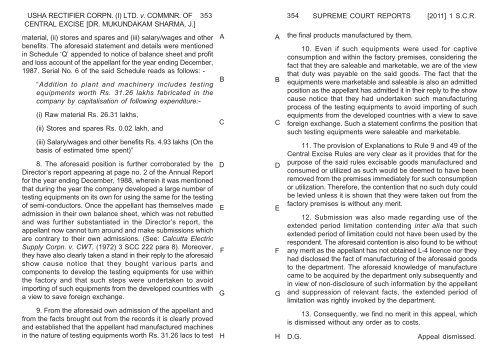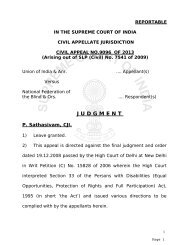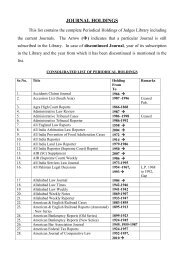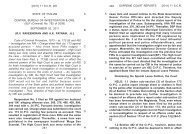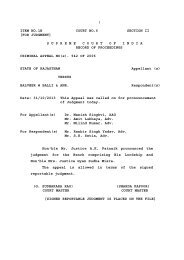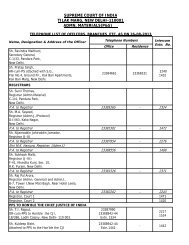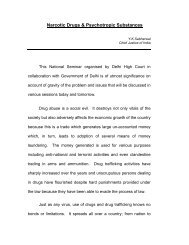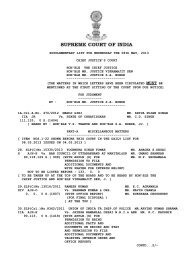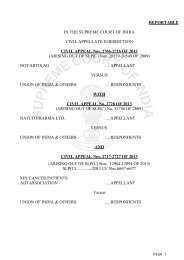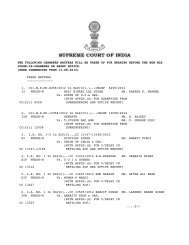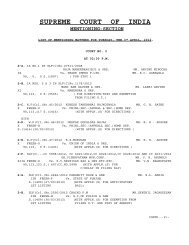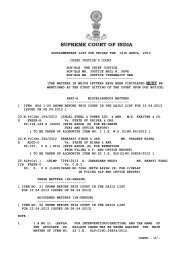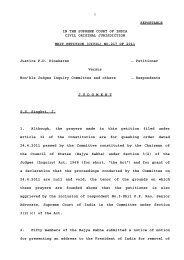Part No.II - Supreme Court of India
Part No.II - Supreme Court of India
Part No.II - Supreme Court of India
You also want an ePaper? Increase the reach of your titles
YUMPU automatically turns print PDFs into web optimized ePapers that Google loves.
USHA RECTIFIER CORPN. (I) LTD. v. COMMNR. OF<br />
CENTRAL EXCISE [DR. MUKUNDAKAM SHARMA, J.]<br />
material, (ii) stores and spares and (iii) salary/wages and other<br />
benefits. The aforesaid statement and details were mentioned<br />
in Schedule ‘Q’ appended to notice <strong>of</strong> balance sheet and pr<strong>of</strong>it<br />
and loss account <strong>of</strong> the appellant for the year ending December,<br />
1987. Serial <strong>No</strong>. 6 <strong>of</strong> the said Schedule reads as follows: -<br />
“Addition to plant and machinery includes testing<br />
equipments worth Rs. 31.26 lakhs fabricated in the<br />
company by capitalisation <strong>of</strong> following expenditure:-<br />
(i) Raw material Rs. 26.31 lakhs,<br />
(ii) Stores and spares Rs. 0.02 lakh, and<br />
(iii) Salary/wages and other benefits Rs. 4.93 lakhs (On the<br />
basis <strong>of</strong> estimated time spent)”<br />
8. The aforesaid position is further corroborated by the<br />
Director’s report appearing at page no. 2 <strong>of</strong> the Annual Report<br />
for the year ending December, 1988, wherein it was mentioned<br />
that during the year the company developed a large number <strong>of</strong><br />
testing equipments on its own for using the same for the testing<br />
<strong>of</strong> semi-conductors. Once the appellant has themselves made<br />
admission in their own balance sheet, which was not rebutted<br />
and was further substantiated in the Director’s report, the<br />
appellant now cannot turn around and make submissions which<br />
are contrary to their own admissions. (See: Calcutta Electric<br />
Supply Corpn. v. CWT, (1972) 3 SCC 222 para 8). Moreover,<br />
they have also clearly taken a stand in their reply to the aforesaid<br />
show cause notice that they bought various parts and<br />
components to develop the testing equipments for use within<br />
the factory and that such steps were undertaken to avoid<br />
importing <strong>of</strong> such equipments from the developed countries with<br />
a view to save foreign exchange.<br />
9. From the aforesaid own admission <strong>of</strong> the appellant and<br />
from the facts brought out from the records it is clearly proved<br />
and established that the appellant had manufactured machines<br />
in the nature <strong>of</strong> testing equipments worth Rs. 31.26 lacs to test<br />
353 354<br />
A<br />
B<br />
C<br />
D<br />
E<br />
F<br />
G<br />
H<br />
A<br />
B<br />
C<br />
D<br />
E<br />
F<br />
G<br />
H<br />
SUPREME COURT REPORTS [2011] 1 S.C.R.<br />
the final products manufactured by them.<br />
10. Even if such equipments were used for captive<br />
consumption and within the factory premises, considering the<br />
fact that they are saleable and marketable, we are <strong>of</strong> the view<br />
that duty was payable on the said goods. The fact that the<br />
equipments were marketable and saleable is also an admitted<br />
position as the appellant has admitted it in their reply to the show<br />
cause notice that they had undertaken such manufacturing<br />
process <strong>of</strong> the testing equipments to avoid importing <strong>of</strong> such<br />
equipments from the developed countries with a view to save<br />
foreign exchange. Such a statement confirms the position that<br />
such testing equipments were saleable and marketable.<br />
11. The provision <strong>of</strong> Explanations to Rule 9 and 49 <strong>of</strong> the<br />
Central Excise Rules are very clear as it provides that for the<br />
purpose <strong>of</strong> the said rules excisable goods manufactured and<br />
consumed or utilized as such would be deemed to have been<br />
removed from the premises immediately for such consumption<br />
or utilization. Therefore, the contention that no such duty could<br />
be levied unless it is shown that they were taken out from the<br />
factory premises is without any merit.<br />
12. Submission was also made regarding use <strong>of</strong> the<br />
extended period limitation contending inter alia that such<br />
extended period <strong>of</strong> limitation could not have been used by the<br />
respondent. The aforesaid contention is also found to be without<br />
any merit as the appellant has not obtained L-4 licence nor they<br />
had disclosed the fact <strong>of</strong> manufacturing <strong>of</strong> the aforesaid goods<br />
to the department. The aforesaid knowledge <strong>of</strong> manufacture<br />
came to be acquired by the department only subsequently and<br />
in view <strong>of</strong> non-disclosure <strong>of</strong> such information by the appellant<br />
and suppression <strong>of</strong> relevant facts, the extended period <strong>of</strong><br />
limitation was rightly invoked by the department.<br />
13. Consequently, we find no merit in this appeal, which<br />
is dismissed without any order as to costs.<br />
D.G. Appeal dismissed.


